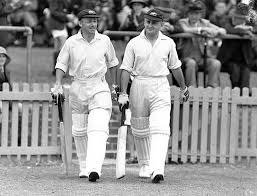If you search for the greatest cricket player of all time, one name that often comes up is Sir Donald Bradman. The Gen Z cricket fans and newer cricket faithful might not know him all that well, and that’s understandable. After all, Bradman played between 1928 and 1948, a time long before televised matches and social media highlights became common.
However, for those lucky enough to have witnessed “The Don” in action, or even heard about him, you’d know that he wasn’t just another cricketer. He was something different. He was a once-in-a-lifetime kind of athlete who dominated the game, and he redefined it.
This article takes a closer look at the life and remarkable career of Sir Donald Bradman, tracing his journey from humble beginnings to becoming a global cricketing icon. We’ll explore his early life, rise to fame, career milestones, records, and even his life beyond the cricket field. But before we dive right in, check out the best odds on upcoming cricket matches and other exciting titles like the Vortex Login Game in your free time.
Early Life and Background
Donald George Bradman was born as the youngest of five kids on August 27, 1908, in a small town called Cootamundra, in New South Wales, Australia. Not long after his birth, his family moved to Bowral, a quiet town in the NSW Southern Highlands, where Bradman would spend much of his early childhood. In Bowral, young Don’s love for cricket began to take shape and started in the most unconventional way.
He reportedly started with a golf ball, a cricket stump, and the curved base of a water tank in his backyard. He would hit the golf ball against the water tank with the cricket stump over and over, for hours. Since the tank would bounce the ball back at unpredictable angles, he had to adjust on the fly, which helped sharpen his reflexes and hand-eye coordination. By the age of 12, Bradman was already a brilliant player at his school, Bowral Public School, scoring his first century at that young age.
Domestic Career
Still in his teenage years, Donald Bradman transitioned from playing high school cricket to representing the local Bowral team. And despite his young age, he was clearly operating on a completely different level. In 1926, he began playing grade cricket for St George in Sydney. On his debut, he scored 110, marking his first century on a turf pitch. At the time, he would make the long trip from Bowral to Sydney every week to play for St. George.
The next year, Bradman made his first-class debut for New South Wales at just 19 years old. He wasted no time announcing himself, as he scored 118 in his very first innings of his debut game. With his exceptional talent, it was only a matter of time before Bradman caught the eye of national selectors.
By the start of the 1928/29 season, England were set to tour Australia, and Bradman knew the opportunity was right there for the taking. Determined to put himself in the spotlight, he moved to Sydney, took a job with the sporting goods retailer Mick Simmons Ltd, and threw himself into Sheffield Shield cricket. And true to expectation, his consistently brilliant performance eventually earned him a call-up to the Australian team.
International Career
Bradman made his international debut in 1928 against a strong England side in Brisbane. However, it was a shaky start for him, as he only managed to score just 18 and 1, and Australia suffered a heavy loss. After that performance, he was dropped for the next game, but he eventually got a second chance in Melbourne due to an injury to a teammate. That was where he truly demonstrated the level of ability for which he was known. At just 20 years old, he scored 79 in the first innings and followed it up with 112 in the second, becoming the youngest player ever to make a Test century.
Two years later, Bradman headed to England for the 1930 Ashes series, and what followed is one of the most remarkable batting performances in cricket history. He began the tour with 236 against Worcester. He ended the series with 974 runs at an average of 139.14.
Over the next two years, Bradman continued to score at an unprecedented rate, and by 1932, his Test average was over 130. He had also already scored ten centuries in just 15 matches. At that point, bowlers around the world were desperate to find a way to stop him. In fact, in response to his dominance, England developed the infamous “Bodyline” strategy during the 1932/33 Ashes, using short-pitched deliveries aimed at the body.
Later career and post-war years
In the following years, Bradman continued to produce match-winning innings despite health issues and the intense public spotlight. He was appointed vice-captain for the 1934 Ashes tour of England, where he scored 304 at Headingley and 244 at The Oval, helping Australia win the series. In the 1936/37 Ashes, he also led one of the greatest comebacks in Test history, turning a 2-0 deficit into a 3-2 series victory. He scored 270 in the deciding match of that series.
Like many others, the Second World War put Bradman’s career on hold for nearly seven years. He served in the military but also struggled with serious health issues. He was diagnosed with fibrositis, which threatened to end his playing career. However, despite doubts over his fitness, Bradman returned to captain Australia after the war and immediately picked up where he left off. In the 1946/47 Ashes, he scored 187, 234, and 118 in consecutive matches, sealing another series win.
Bradman’s career ultimately culminated in one of the most famous moments in cricket. In his final Test innings at The Oval, he needed just four runs to finish with a career batting average of exactly 100. Instead, he went out without scoring any runs, leaving his final career average at 99.94. When Bradman retired, he had scored 6,996 runs in 52 Tests. He was widely regarded as the greatest batsman, and arguably the greatest cricketer, of all time.
Personal, Post-Retirement Life, and Passing
After hanging up his bat, Bradman was a selector and administrator on the Australian Cricket Board. He also wrote books, including “The Art of Cricket,” where he outlined his approach to the game. Outside cricket, he had a love for music, especially the piano. He also enjoyed golf. He got married to Jessie Menzies in 1932, and together, they had two children. They shared a long life until her passing in 1997.
Bradman himself passed away on February 25, 2001, at the age of 9, followed by numerous heartfelt tributes from fans, former players, and even world leaders. Australia held a state funeral in his honor. Today, his birthplace at Cootamundra is now a museum.
Conclusion
It’s hard to wrap up a life like Donald Bradman’s in neat words. By every statistical measure, he stands as the greatest batsman the game has ever seen. He didn’t just play cricket, he transformed it and left a legacy that will forever inspire generations.


